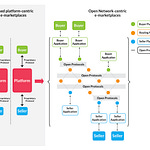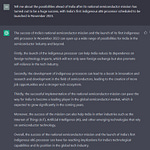Siliconpolitik: Where Do We Go Now?
— Pranay Kotasthane
I have a follow-up paper for NUS-ISAS discussing the next steps for the Quad Semiconductor Supply Chain initiative. I argue that the Quad Principles Document on Technology Design, Development, Governance and Use is a good reference point for the collaboration on semiconductors.
An initiative to map capacity and identify vulnerabilities is a welcome first step. However, a lot more needs to be done to create a secure, resilient semiconductor supply chain. Another vital document released on 24th September — the Quad Principles on Technology Design, Development, Governance, and Use document — serves as a helpful guide for realising the ultimate goal. This section maps key principles in the document to potential initiatives in the semiconductor domain.
One, the document on principles argues that resilient, diverse, and secure technology supply chains are vital to the shared national interests of the Quad countries. To achieve this goal, the document advocates "close cooperation on supply chains with allies and partners who share our values” since this “will enhance our security and prosperity, and strengthen our capacity to respond to international disasters and emergencies."
A way to map this principle to the semiconductor domain would be to form a Quad semiconductor consortium that manages a jointly held Quad Supply Chain Resilience Fund. This consortium can then create a roadmap for new semiconductor manufacturing facilities across the Quad countries. The goal should be to ensure redundancy in the ecosystem such that this supply chain is not susceptible to geopolitical or geographic risks. For instance, while the US focuses on restarting manufacturing at leading-edge nodes (5 nanometres and below), the consortium could work together to build specialised analog, memory foundries operating at trailing-edge nodes (45nm and above) in India, Japan, or Australia.
Another way to realise this principle is for the consortium to create one centre for excellence (CoE) in each Quad country in an area of its immediate interest. For example, Australia could host the CoE for new materials in electronics, Japan could host the CoE for silicon manufacturing equipment, while the US and India could host CoEs on fabless design architectures.
Two, the principles document recognises the importance of "international standards development that foster interoperability, compatibility, and inclusiveness." This principle can translate into cooperation on developing new standards for open-standard instruction set architectures such as RISC-V and for manufacturing on semiconductor composites such as Gallium Nitride.
Three, the principles document underscores that the Quad countries are "committed to facilitating the exchange of researchers and movement of highly skilled personnel to enhance science and technology collaboration". This applies well to semiconductor R&D cooperation, where governments can do a lot to foster technology exchange, visitation and research participation, and joint development between companies in the Quad countries. For instance, lowering employment barriers for semiconductor professionals in the Quad countries could facilitate more joint development. Beyond skilled personnel movement, lowering investment barriers and export controls within the Quad bubble can facilitate more cross-licensing arrangements.
Further, I identify three key factors that could determine how far this initiative goes:
One, the US needs to review its approach to technology protection in the semiconductor domain. Given that US-headquartered companies alone account for 62 per cent of global fabless firm revenues and 51 per cent of global integrated design manufacturers (IDM) revenues, the US role in creating a resilient supply chain is critical.
In the past, the US government adopted strict trade and regulatory mechanisms restricting technology transfer. This restrictive approach needs to give way to a collaborative mode in the Quad. In a paper titled "An Allied Approach to Semiconductor Leadership", Stephen Ezell lists some measures that the US could take. These include enrolling partner countries in trusted foundries programmes, co-investing in semiconductor moonshots, reducing export controls, lowering foreign investment screening barriers with like-minded countries, and sharing information on intellectual property theft. Just as the US is now willing to share critical technologies with partners through the AUKUS defence arrangement, an allied approach should be adopted in the semiconductor domain.
Two, all four Quad countries need to work to increase trust in each other's legal enforcement mechanisms. The four members need to harmonise their contract enforcement, regulatory practices, and patent protection mechanisms. Such measures will encourage companies to collaborate across borders.
Three, the Semiconductor Supply Chain Initiative should become a platform that coalesces other powers in this domain, such as Taiwan, South Korea, Israel, Singapore, and the European Union (EU). The larger the grouping of like-minded countries, the more resilient and secure the semiconductor supply chain is likely to be.
What do you think?
Antriksh Matters #1:Lab On A Chip for Space Missions
— Ruturaj Gowaikar
Indian Space Research Organisation (ISRO) and Indian Institute of Science (IISc) have jointly prepared a device to conduct cell biology-based experiments in space. The device, called MANAS, Sanskrit for Mind stands for Microbial Analysis in Space. It is a technology demonstrator and uses the lab-on-a-chip (LOC) concept. The details of this device were published in the Journal Acta Astronautica.
Cell-biology experiments in space
Microgravity, as experienced in space, be it in low earth orbit (LEO) or outer space, can affect various cell processes at the cellular and subcellular level. These effects can vary from alteration to the cytoskeleton and shape of a cell, to alteration in the metabolism of cells. The effect of this is that pathogenic microbes might behave differently in space and insight into their growth dynamics can have a bearing on the health of personnel involved in manned-space missions. Altered growth rates also affect microbial output of space bioreactors being developed for manned missions. The aim of these bioreactors is to produce protein-based medicines, help in recycling water on-board etc. in order to reduce frequency of re-supply missions. India’s manned space mission- Gaganyaan – is underway and platforms like MANAS are useful to conduct preparatory experiments for future missioClonger durations.
Design of MANAS
MANAS is a milli-fluidic device that was fabricated using 3D printing while some components were CNC machined. It consists of a cylindrical cavity in an aluminum block called the bacterial chamber and some smaller antechambers. It is surrounded by optically transparent material (PMMA) plates. This allows the LED and photo-diode sensors to measure optical cell density-the standard way to count cells using principles of spectroscopy. It has a modular design so multiple such chambers can be housed together to form cassettes designed specifically to conduct one experiment. Such multiple cassettes can also be loaded as cartridges to perform different experiments. The device has a microcontroller to initiate the experiment remotely, measure the optical density (OD), and store data on-board.
MANAS was tested using the spore forming bacteria Sporosarcina pasteurii. The bacteria were deactivated metabolically by converting them into spores. Spores were then lyophilized and suspended in a sucrose solution and loaded into MANAS, while the nutrient media was kept in a different chamber separated by a NC solenoid. The OD scores were a readout for the growth and were used to prepare growth curves. The growth curves were cross-validated using electron-microscopy. MANAS was tested under vacuum conditions and altered atmospheric conditions as well.
The bacteria chosen is also significant because it is an ureolytic bacteria and thus can prepare calcium carbonate crystals. ISRO research on this bacterium has made it a contender to form space bricks for lunar habitation.
Thus, this self-contained, leak proof, orientation-agnostic, remotely operable LOC platform is one small step in the right direction for India’s space research programme. The next step is to test it in flight mode and design more complex experiments.
Antriksh Matters #2: Lessons from UK’s National Space Strategy
— Aditya Pareek
The UK has come out with its first ever national space strategy document. The document builds on the UK’s Integrated Review and Defence Command Paper that came out earlier this year and featured space prominently.
The strategy document has several aspects which any similar strategic publication on space by India could also take inspiration from and integrate:
1. A focus on “Whole Ecosystem Approach” for the advancement of the Indian space sector.
2. Focus on procurement of dual-use space technologies and platforms for the fulfilment of national space goals - without compromising on the deliverable specs.
3. Focus on making space sustainable by actively contributing to space debris removal, and explore technologies and services that may extend the service life of satellites and other space objects while in orbit.
4. Earmarking a venture capital fund for private finance access to New Space sector companies - along the lines of UK’s Seraphim Space Investment Trust.
5. Acknowledge the operating environment vis a vis adversarial counterspace capabilities and include a back-of-the-envelope estimate for potential damage they can inflict on Indian economy.
Check out the All Things Policy Podcast featuring our take on the UK’s national space strategy here.
If the content in this newsletter interests you, consider taking up Takshashila’s short course on Evidence-based policy-making for responding to COVID-19. The course introduces participants to the various public policy aspects of managing recurring COVID-19 waves. Topics will include the role of the government, tackling misinformation, ethical decision-making during a pandemic, and the adoption of emerging technologies to fight the pandemic. You can register yourself for this course on or before 21st October 2021. To know more, click here.
Yogakshema: An US-EU Tech Partnership in the Making
— Arjun Gargeyas
Officials from both the European Union (EU) and United States (US) met in Pittsburgh a couple of weeks back for the first-ever meeting of the “EU-US Trade and Technology Council” (TTC). This comes on the back of the Quad summit, where technology played an important role in the discussions, especially in outlining the main objectives of the ‘Critical and Emerging Technologies Working Group’ by the alliance. It is also following the declaration of the AUKUS pact, with the US and UK signing agreements to transfer nuclear submarine technology to Australia.
The rise of China and its influence on the global technology ecosystem through its tech giants have made the West, and especially the United States, take a fresh look at mechanisms for regulating and using critical technologies. Despite sharing concerns with regard to China’s technological growth and the global semiconductor chip shortage, the US and EU have very differing views on how to regulate the use of technology. The new EU-US technology council will have a hard time navigating the partnership as it looks to counter China’s tech dominance.
Trying to Find a Middle Ground
The European Union’s approach to regulating and governing technology has evolved from an individual-centric approach keeping in mind the rights of its citizens. Fundamental rights like privacy have been accorded the greatest importance when it comes to framing laws related to technology. This can be seen from the General Data Protection Regulation (GDPR) Act, which addresses data protection and privacy in the European Union along with protecting personal data from being shared outside the EU area. The EU has been willing to intervene when it feels that the rights of European citizens have been infringed upon by any public or private entity.
The United States, on the other hand, has always followed a minimal regulatory framework on technology. It has stressed how multiple rules and regulations might hamper the growth of emerging technologies. Following a market-driven and hands-off approach to governing technology, the United States has let the private sector and institutions take the lead while providing just minimal responsibilities to the state.
This makes it necessary for both the actors to arrive at a compromise. But this kind of differential pattern also allows for both to complement each other’s strengths. The partnership can eventually help the EU obtain the geopolitical relevance that the US owns in the field while the US can obtain the rights and freedoms relevance that the EU policies champion. However, this requires political alignment which is yet to be seen between the two. Time will tell whether both will compromise on the principles they follow while regulating technology.
The French Reservation
While the first summit of the US-EU TTC focused on the ongoing semiconductor shortages, regulation of artificial intelligence technology, and the upholding of competition in tech, reports said that there were some grumblings from a certain EU member regarding the discussions which took place at the summit. French diplomats specifically asked to remove certain clauses and language which referred to a proposed semiconductor supply chain that mentioned the mutual dependency between the US and EU.
France also has differing opinions when it comes to the security of supply aspects with it looking beyond just semiconductor chips as a potential shortage of supply. This has made the French stress on a rather cautious approach towards a potential US-EU partnership, with it emphasising the need to rebuild transatlantic trust.
The French anger over the AUKUS deal seems to have subsided but the overall reservation they hold can put the brakes on the working of the TTC, which looks to take off soon.
What will the focus be on?
The EU comprises over 25 different countries with contrasting views and interests.
Other than the China-centric focus, the EU partnership with the US should be driven by easier access to and dissemination of technology. Foreign investments in each other’s regions and reducing dependencies on global supply chains of critical technologies should be the focus of the TTC. Better collaboration in the research and development field of emerging technologies between technically advanced blocs like the US and EU can eventually act as a counterbalancing measure against the increasing Chinese influence.
The question which remains is, will the US and EU’s common anxieties and fears help to forge a credible working partnership or will the dream of a transatlantic technology group remain just a dream? George W. Bush and Barack Obama, during their time in office, tried bringing the EU to the table for better cooperation on technology but eventually failed. Will the rapid rise of China in the technology space during the past decade possibly provide a new impetus to the partnership?
CyberPolitik : DCNs are trying Regulatory Fixes (Again, and again)
— Sapni G K
Over the past few editions, we have presented our working idea of what a Digital Communications Network is. Commentators across the globe have identified the difficulty in finding adequate regulatory responses to the fissures that appear in our lives that are intertwined with DCNs. We have also warned that regulatory fixes for the troubles of (some may say troubles caused by) DCNs are not easy to find. While policymakers across the globe scratch their heads looking for solutions, these DCNs have suggestions to offer.
It is not the first time suggestions come from the very platforms that are due for regulation. Such overtures into policymaking have been attempted by every industry that attracted global attention, from telecom to tobacco. The technology industry itself has ventured into designing regulatory solutions. As governments are evidently not keen on this sort of self-regulation to continue, new tactics emerge from the playbooks of tech giants.
Twitter released a position paper titled “Protecting the open Internet” on 13 October 2021. It outlines five broad guiding principles for the regulation of the internet. In short, it calls for the adoption of universal standards for the internet and its regulation, while adhering to established norms of human rights. It recasts the decades-old vision of a cyber utopia, which has sadly come crumbling down. Trust, competition, and transparency are central to Twitter’s recommendations. It proclaims that this vision would help big and small players alike, and honour the vision of the internet. Such documents or recommendations, called by their myriad titles, have been produced by every tech company and the multitude of people who helm them.
However, things are different in practice. In response to regulatory warnings in Australia, a misinformation oversight committee was created within the Digital Industry Group Inc. (DIGI), an industry body publicly backed by Facebook, Google, and Twitter. This contradicts Twitter’s proclamations for open standards and giving space to smaller players. As India moves ahead in regulating DCNs, this experience gives us two valuable lessons. Firstly, taking the proclamations they make at face value might not be in the best interest of our society or the regulatory regime that we intend to create. Secondly, DCNs should have access to the policymakers’ tables, but it must be as limited as any other stakeholder group such as civil society or law enforcement agencies. Devoting more attention, time and regard may give way to them usurping the process to the possible loss of other stakeholders and industry players.
Antriksh Matters #3: ISpA a new beginning?
— Aditya Ramanathan
On 11 October, India’s Prime Minister made a clear indication of the importance the government attaches to India’s commercial space sector. Launching the industry body, the Indian Space Association, the Prime Minister identified four “pillars” of space reform: freedom of innovation for the private sector, the role of the government as an enabler, preparing India’s young workforce for the future, and to see the space sector as a resource for the development of the wider populace.
The founding members of the Indian Space Association are largely established vendors for ISRO. For instance, last year, Larson & Toubro provided a booster segment for ISRO’s Gaganyaan Launch Vehicle, that is key to India’s human spaceflight programme. Another long-time ISRO vendor is Walchandnagar Industries, which is presently helping to develop solid propellant boosters for the GSLV Mk III launchers. One of the newer companies on the list of founding members is OneWeb, the satellite internet company backed by a consortium of investors led by Bharti Enterprises. During the launch of the Indian Space Association, Bharti Enterprises chairman Sunil Mittal announced that OneWeb would soon become ISRO’s first private Indian customer for satellite launches.
Other core members of the association include Hughes India, Centum Electronics, state-owned BEL, and Maxar India.
That the Indian Space Association is dominated by ISRO’s vendors (barring exceptions like OneWeb), is a natural result of the way India’s space sector has evolved for decades, with private players simply acting as suppliers.
The Indian Space Association will also presumably complement and compete with existing representative bodies like the Satcom Industry Association and Association of Geospatial Industries. Given the Indian Space Association’s backing from industry and the government (it will be headed by Lt. General A.K. Bhat, a decorated officer who retired from service last year), it will not be surprising if it supersedes the existing organisations.
While the Indian Space Association will provide commercial space players a mechanism to both consult each other and approach the government, its success will ultimately depend on the receptiveness of the government. If India is to achieve the vision laid out by the Prime Minister, it will need to move faster. In 2020, it set up the regulatory body INSPACe under the Department of Space. However, it took until September this year to appoint Pawan Goenka, the former managing director of Mahindra & Mahindra as its chairperson. While the appointment of an auto industry stalwart (rather than a government official) was widely welcomed, it took too long, suggesting resistance from within the system. The government must now work to staff up INSPACe and respond quickly to what is reportedly a growing pile of pending applications from private players. More broadly, it provide a fresh set of regulations and policies that will allow India’s space industry to grow from vendors into world-class spacefarers.
Our Reading Menu
[Opinion] Robert Reich characterises the Supreme court of USA, Facebook, and the Fed as the horsemen of democracy’s apocalypse drawing a thread of unaccountability from them as wielders of great power.
[Book] “On Operations” by Capt. B. A. Friedman USMC Reserve.
[Book] Klimat: Russia in the Age of Climate Change by Thane Gustafson.
[Policy Communique] detailing the EU’s Arctic Strategy.











Share this post